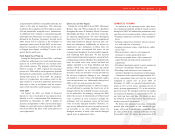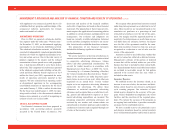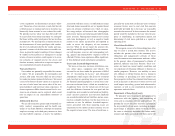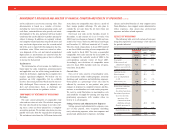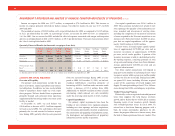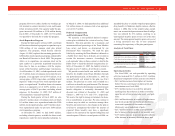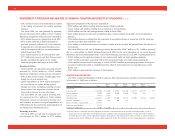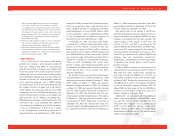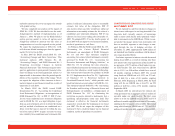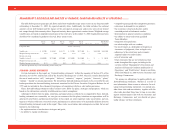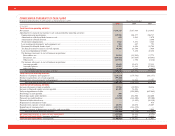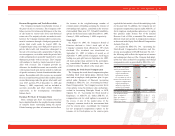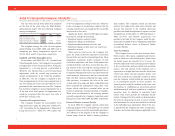Advance Auto Parts 2005 Annual Report Download - page 34
Download and view the complete annual report
Please find page 34 of the 2005 Advance Auto Parts annual report below. You can navigate through the pages in the report by either clicking on the pages listed below, or by using the keyword search tool below to find specific information within the annual report.
The senior credit facility is secured by a first priority
lien on substantially all of our assets and the assets of
our existing domestic subsidiaries, subject to certain
exceptions, and will be secured by the properties and
assets of our future domestic subsidiaries. The senior
credit facility contains covenants restricting the ability
of us and our subsidiaries to, among other things, (1)
declare dividends or redeem or repurchase capital
stock, (2) prepay, redeem or purchase debt, (3) incur
liens or engage in sale-leaseback transactions, (4)
make loans and investments, (5) incur additional debt
(including hedging arrangements), (6) engage in certain
mergers, acquisitions and asset sales, (7) engage in
transactions with affiliates, (8) change the nature of
our business and the business conducted by our sub-
sidiaries and (9) change our passive holding company
status. We also are required to comply with financial
covenants with respect to a maximum leverage ratio,
a minimum interest coverage ratio, a minimum cur-
rent assets to funded senior debt ratio, a maximum
senior leverage ratio and limits on capital expendi-
tures. We were in compliance with the above
covenants at December 31, 2005.
CREDIT RATINGS
At December 31, 2005, we had a credit rating on
our senior credit facility from Standard & Poor’s of
BB+ and a credit rating of Ba1 from Moody’s
Investor Service. The current pricing grid used to
determine our borrowing rates under our senior cred-
it facility is based on such credit ratings. If these
credit ratings decline, our interest expense may
increase. Conversely, if these credit ratings increase,
our interest expense may decrease.
SEASONALITY
Our business is somewhat seasonal in nature, with
the highest sales occurring in the spring and summer
months. In addition, our business can be affected by
weather conditions. While unusually heavy precipi-
tation tends to soften sales as elective maintenance is
deferred during such periods, extremely hot or cold
weather tends to enhance sales by causing automo-
tive parts to fail at an accelerated rate.
RECENT ACCOUNTING PRONOUNCEMENTS
In November 2004 the FASB issued SFAS No.
151, “Inventory Costs.” The new statement amends
Accounting Research Bulletin No. 43, Chapter 4,
“Inventory Pricing,” to clarify the accounting for
abnormal amounts of idle facility expense, freight,
handling costs and wasted material. This statement
requires that those items be recognized as current-
period charges and requires that allocation of fixed
production overheads to the cost of conversion be
based on the normal capacity of the production facil-
ities. This statement is effective for fiscal years
beginning after June 15, 2005. We do not expect the
adoption of this statement to have a material impact
on our financial condition, results of operations or
cash flows.
In December 2004 the FASB issued SFAS No. 123
(revised 2004), “Share-Based Payment,” or SFAS
No. 123R. SFAS No. 123R replaces SFAS No. 123
and supersedes APB Opinion No. 25 and subse-
quently issued stock option related guidance. SFAS
No. 123R establishes standards for the accounting
for transactions in which an entity exchanges its
equity instruments for goods or services, primarily
on accounting for transactions in which an entity
obtains employee services in share-based payment
transactions. It also addresses transactions in which
an entity incurs liabilities in exchange for goods or
services that are based on the fair value of the enti-
ty’s equity instruments or that may be settled by the
issuance of those equity instruments. Entities will be
required to measure the cost of employee services
received in exchange for an award of equity instru-
ments based on the grant-date fair value of the award
(with limited exceptions). That cost will be recog-
nized over the period during which an employee is
required to provide service in exchange for the award
(usually the vesting period). The grant-date fair
value of employee share options and similar instru-
ments will be estimated using option-pricing mod-
els. If an equity award is modified after the grant
date, incremental compensation cost will be recog-
nized in an amount equal to the excess of the fair
value of the modified award over the fair value of the
original award immediately before the modification.
We are required to apply SFAS No. 123R to all
stock or stock-based awards outstanding and subse-
quently granted, modified or settled as of January 1,
2006. SFAS No. 123R requires us to use either the
modified-prospective method or modified-retro-
spective method. Under the modified-prospective
method, we must recognize compensation cost for all
awards subsequent to adopting the standard and for
the unvested portion of previously granted awards
outstanding upon adoption. Under the modified-ret-
rospective method, we must restate our previously
issued financial statements to recognize the amounts
we previously calculated and reported on a pro
forma basis, as if the prior standard had been adopt-
ed. Under both methods, SFAS No. 123R permits the
use of either the straight line or an accelerated
32
MANAGEMENT’S DISCUSSION AND ANALYSIS OF FINANCIAL CONDITION AND RESULTS OF OPERATIONS
(continued)



